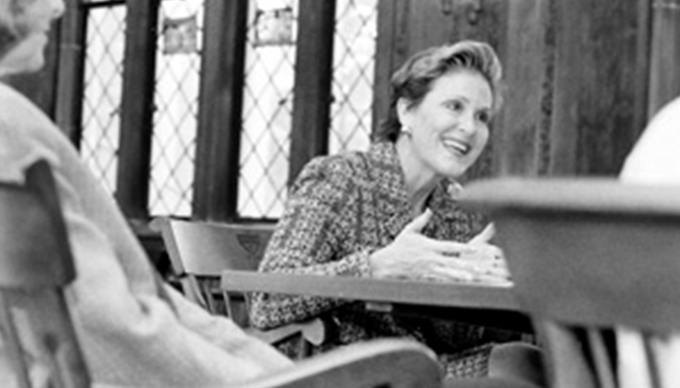Dr. Rodin grew up in West Philadelphia, just a short walk away from the University of Pennsylvania.
She attended Penn as a scholarship student, studying psychology (class of 1966). Later returning as the University’s president—the first Penn graduate to serve in the role, and the first woman to permanently lead an Ivy League institution—Dr. Rodin presided over an unprecedented decade of growth and progress that transformed Penn, its campus, and the West Philadelphia community.
 Under Dr. Rodin’s leadership, Penn doubled its research funding and tripled both its annual fundraising and the size of its endowment. It launched the West Philadelphia Initiative, a comprehensive, award-winning, and internationally acclaimed neighborhood revitalization program—as well as the Agenda for Excellence, which raised the standards of an undergraduate education at Penn. As a result, the University attracted record numbers of undergraduate applicants, welcoming its most selective classes in history, while climbing from 16th to 4th in the leading national rankings.
Under Dr. Rodin’s leadership, Penn doubled its research funding and tripled both its annual fundraising and the size of its endowment. It launched the West Philadelphia Initiative, a comprehensive, award-winning, and internationally acclaimed neighborhood revitalization program—as well as the Agenda for Excellence, which raised the standards of an undergraduate education at Penn. As a result, the University attracted record numbers of undergraduate applicants, welcoming its most selective classes in history, while climbing from 16th to 4th in the leading national rankings.
In 2004, Dr. Rodin received both the Philadelphia Award and William Penn Award. In 2006, she was awarded the Pennsylvania Society’s Gold Medal for Distinguished Achievement. She was the first person to receive all three awards, a recognition of her impact on the city and commonwealth.
Currently President emerita, Dr. Rodin’s legacy includes:
Enriching Undergraduate Education
- College House System: Created a comprehensive College House residential system with 11 new houses, offering students 21st century facilities, including computer labs, faculty apartments, and office and activity spaces. This new system helped to create diverse, cohesive student communities, and promoted a broad array of opportunities for academic and intellectual exchange.
- Thematic Houses: Created themed resource houses, facilitating smaller, closer-knit communities of students, faculty, and local Philadelphia experts to further explore their academic interests, passions, and cultures in greater depth outside of the classroom setting.
- Interdisciplinary Degrees: Emphasized the study of 21st-century issues that cut across traditional academic departments by offering new interdisciplinary degrees, as well as establishing new institutes like the Center for Global Women’s Health and the Institute for Strategic Threat Analysis & Response.
- Applications and Enrollment: Attracted record numbers of undergraduate applicants, and welcomed the most selective classes in Penn’s history, with a 51.7% increase in selectivity from 1993.
Neighborhood Revitalization
Rather than insulating the university from the neighborhoods it inhabited, Dr. Rodin and her team developed an integrated, five-part strategy for making West Philadelphia safer, livelier, and more prosperous for all its residents.
- Diverse, Affordable, High-Quality Housing: Rehabilitated vacant properties, renovated private homes, and created new rental units—creating better, more affordable housing for West Philadelphia residents while invigorating the local economy.
- Retail Revival: Led the creation of new, mixed-use commercial developments, including shops, restaurants, theaters, and free studio space for local artists—breathing new life into an abandoned commercial corridor and effectively bringing the Penn community out of the ivory tower and into the neighborhood.
- Inclusive Economic Growth: Awarded hundreds of millions in contracts to women and minority-owned businesses. Created a pipeline for local residents to access training and jobs across the university.
- Investing in Local Public Schools: Substantially deepened Penn’s involvement in all West Philadelphia public schools, with a focus on technology, teacher education, and curriculum development—including an effort led by the chair of Penn’s Mathematics Department to redesign the math curriculum for local K-12 schools.
-
- The Penn Alexander School: Planned and built a first-of-its-kind, pre-K-through-8 school in collaboration with the city, the school district, and the Philadelphia Federation of Teachers. The Penn Alexander School’s diverse student body reflects the makeup of West Philadelphia, with substantially smaller classes and higher-performing students than the citywide average.
Creating Penn Medicine
- Saving the University of Pennsylvania Health system (UPHS): Only a few short years into Dr. Rodin’s tenure, the Balanced Budget Act of 1997 threw Penn’s Health System into crisis. By 1999, it was losing hundreds of millions—much of which it had borrowed from the University. Many believed that the only way out was to break up the system and sell some of the University’s historic hospitals to the private sector.Instead, under Dr. Rodin’s leadership, Penn saved its hospitals and doubled down on its commitment to health care–but in new ways that anticipated many of the challenges of the 21st century:
-
- Penn’s leadership team created a new, self-regulating medical system, integrating Penn’s vast network of hospitals, treatment centers, clinical practices, and the School of Medicine, under the aegis of a single nonprofit: Penn Medicine.
- Just a few years after losing hundreds of millions of dollars, Penn’s hospitals turned a profit, and received some of the most prestigious awards in health care.
- Today, Penn Medicine has catapulted in the rankings, and is viewed as one of the top-three academic medical systems in the world, receiving $720 million annually in sponsored research.

